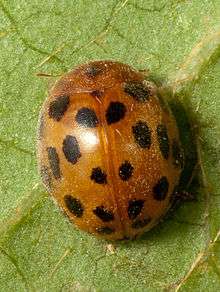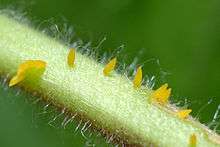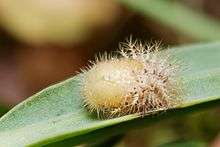Subcoccinella vigintiquatuorpunctata
| 24-spot Ladybird | |
|---|---|
 | |
| Scientific classification | |
| Kingdom: | Animalia |
| Phylum: | Arthropoda |
| Class: | Insecta |
| Order: | Coleoptera |
| Family: | Coccinellidae |
| Subfamily: | Epilachninae |
| Genus: | Subcoccinella |
| Species: | S. vigintiquatuorpunctata |
| Binomial name | |
| Subcoccinella vigintiquatuorpunctata (Linnaeus, 1758) | |
| Synonyms | |
|
Coccinella vigintiquatuorpunctata | |
Subcoccinella vigintiquatuorpunctata (the 24-spot ladybird) is a beetle in the family Coccinellidae. It is the only member of the genus Subcoccinella. It has the typical, almost semi-spherical, ladybird shape and is patterned with spots. However it differs from many of the well-known ladybirds in being neither smooth and shiny nor an eater of aphids: the wing-cases look velvety and it eats plants.
Names
The common names for this insect in many languages follow the binomial name and mention that it has twenty-four spots,[1] but in English there is great variation in how this is written, with little consensus over the use of words or numerals, capitalisation, placement of hyphens and whether to use "spot", "spotted", "point" or "pointed"; "ladybird", "ladybird beetle" or "ladybug". There is even disagreement about the spelling of the Latin "vigintiquatuorpunctata" with some authoritative UK lists preferring a double "t": "vigintiquattuopunctata".[2] For ease it is often written "Subcoccinella 24-punctata". Given the multitude of name formations, it is probably best to use just the genus "Subcoccinella" when carrying out a web search for information about this insect to avoid missing texts that use variant spellings - it's the only species in the genus. In the US it is also known as the "Alfalfa Lady Beetle",[3] though rarely found on alfalfa in North America.[4]
Description
The adult 24-spot is a small ladybird, usually 3 to 4 mm long. It has the quintessential ladybird shape, quite domed with the sides forming a smooth curve from head to pronotum to wing-cases. The wing-cases are covered with short pale hairs, and though these are hard to see without a hand lens, they give the ladybird a distinctive matt appearance. The ladybird is dark orange, including legs and antennae. There are black spots on the wing cases. These vary in number and size but there are often about 20 to 24 and usually no more than 26. Sometimes spots are joined together or they can be absent completely. Dark (melanic) forms are very rare. Another extremely rare form has yellow spots.[5]
Larvae are 4 to 6mm long and pale grey-green with darker speckles.[6] They are covered with branched spines. These spines are also present in the pupa, enabling the pupa to secrete noxious alkaloids as a defence against predators.[7]
There are five European species in the Epilachninae subfamily, all herbivorous and somewhat hairy. The 24-spot Ladybird can be distinguished from the similarly patterned Bryony Ladybird - Henosepilachna argus (6 to 8 mm) by its small size (3 to 4 mm).[8] Cynegetis impunctata, another small ladybird, is browner and has no spots. It also has a black head and this separates it from the form of the 24-spot Ladybird without spots.[9]
This ladybird usually has no wings under the elytra (wing cases) and these individuals are unable to fly. A study found no winged specimens in a UK sample whereas 40% of those from Hungary and Romania had wings. However, as even the winged specimens carried the gene that causes atrophy, it is thought that winglessness is a trend that will increase.[10]
Adult beetles
 Adult (walking) |
 Adult - form without spots |
Juvenile stages
 Eggs |
 Larva |
 Pupa |
Distribution
This ladybird is an Old World species occurring across Europe. It ranges south into parts of north Africa and eastwards through northern Asia excluding China.[11] It was introduced into North America some time last century with the first records from Pennsylvania in 1972.[12] In Britain it is more common in the south.[13]
References
- ↑ Wikispecies:Subcoccinella vigintiquatuorpunctata
- ↑ "Subcoccinella vigintiquattuorpunctata". NBN - National Biodiversity Network Gateway. Archived from the original on 2014-01-12. Retrieved 11 Jan 2014.
- ↑ "Genus Subcoccinella". BugGuide. Archived from the original on 2014-01-12. Retrieved 11 Jan 2014.
- ↑ Gordon, Robert D. (1985). "The Coccinellidae (Coleoptera) of America North of Mexico". Journal of the New York Entomological Society Vol. 93, JANUARY 1985, No. 1: 873. Retrieved 11 Jan 2014.
- ↑ "Subcoccinella vigintiquattuorpunctata". WCG - Website of the Watford Coleoptera Group. Archived from the original on 2012-03-17. Retrieved 10 Jan 2014.
- ↑ "Larvae of UK Ladybirds" (PDF). UK Ladybird Survey. Archived from the original (PDF) on 2013-07-18. Retrieved 11 Jan 2014.
- ↑ Hodek, Ivo; Helmut F. van Emden (2012). Ecology and Behaviour of the Ladybird Beetles (Coccinellidae) (Google eBook). John Wiley & Sons. Retrieved 11 Jan 2014.
- ↑ "The London and Essex Ladybird Surveys". Archived from the original on 2013-11-05. Retrieved 11 Jan 2014.
- ↑ "Subcoccinella vigintiquatuorpunctata". coccinellidae.net. Archived from the original on 2009-01-07. Retrieved 11 Jan 2014.
- ↑ Baldwin, A. J. (1990). "Further biological observations on Subcoccinella vigintiquattuorpunctata". Entomologist's Monthly Magazine. 126 (1516-1519): 223–229. Archived from the original on 2014-01-12. Retrieved 11 Jan 2014.
- ↑ "ITIS Report: Subcoccinella vigintiquatuorpunctata". Archived from the original on 2014-01-13. Retrieved 13 Jan 2014.
- ↑ Wheeler, A. G. Jr. (1993). "Subcoccinella vigintiqualuorpunclala (L.), First Virginia Record and New North American Host of an Adventive Lady Beetle (Coleoptera: Coccinellidae)" (PDF). Banisteria. Virginia Natural History Society (2): 22. Archived from the original (PDF) on 2014-01-13. Retrieved 13 Jan 2014.
- ↑ "NBN Grid map - Subcoccinella vigintiquattuorpunctata". UK: NBN - National Biodiversity Network. Archived from the original on 2014-01-13. Retrieved 13 Jan 2014.
| Wikimedia Commons has media related to Subcoccinella vigintiquatuorpunctata. |
| Wikispecies has information related to: Subcoccinella vigintiquatuorpunctata |